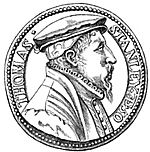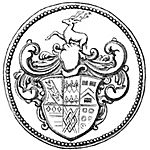Edward Hawkins (numismatist) facts for kids
Quick facts for kids
Edward Hawkins
|
|
|---|---|
| Born | 5 May 1780 |
| Died | 22 May 1867 |
| Nationality | British |
| Alma mater |
|
| Occupation | |
| Spouse(s) | Eliza Rohde |
| Children | 4 |
Edward Hawkins (born May 5, 1780 – died May 22, 1867) was an important English expert on coins and old objects. For over 30 years, he was in charge of the ancient artifacts collection at the famous British Museum. He was known as a numismatist (someone who studies coins) and an antiquary (someone who studies old things).
Contents
Life of Edward Hawkins
Edward Hawkins was born in Macclesfield, England, on May 5, 1780. His father, also named Edward Hawkins, was a banker. As a young child, Edward even met the famous writer Dr. Samuel Johnson shortly before Johnson passed away.
Early Life and Education
Edward went to Macclesfield grammar school. After that, he had a private tutor from 1797 to 1799. Around 1799, he went back to Macclesfield. He worked with his father at the Macclesfield bank until 1802.
Moving to Wales and New Interests
In 1802, his family moved to Court Herbert in Glamorganshire, Wales. There, he worked with his father in a bank in Swansea. They also helped manage copper factories nearby.
In 1807, Edward left Court Herbert and lived in different places in North Wales. During this time, he became very interested in plants, a study called botany. He became a member of the Linnean Society in 1806, which is a group for natural scientists. He also started collecting books and pictures about Chester.
Later Life and British Museum Role
In 1819, Hawkins moved to Surrey, England. In 1821, he was chosen to be a Fellow of the Royal Society, a very respected scientific group. He later became a vice-president of this society.
In 1826, Edward Hawkins got a big job: he became the Keeper of Antiquities at the British Museum. This meant he was in charge of all the ancient objects, including coins, medals, and old drawings. He held this important position until he retired at the end of 1860.
He was also the president of the Numismatic Society of London, which focuses on coins. He was a member and vice-president of the Society of Antiquaries of London, a group that studies old things. Edward Hawkins passed away in London on May 22, 1867, when he was 87 years old.
Edward Hawkins's Works
Edward Hawkins was known for his many writings and collections. He helped edit and write parts of books that described ancient marbles and coins in the British Museum.
Books and Publications
One of his most famous books was The Silver Coins of England, published in 1841. This book became the main guide for studying English silver coins. Later editions of this book were updated by other experts.
He also wrote a detailed account of British medals. A shorter version of this work was printed in 1852. The British Museum at first didn't want to publish the full work because Hawkins had included some strong personal opinions in it. However, after it was completed and updated by other experts, it was finally published in 1885. It was called Medallic Illustrations of the History of Great Britain and Ireland. This book also became a very important guide for studying British medals.
Collections
Edward Hawkins had a deep knowledge of British medals. He built his own large collection of them, which the British Museum bought from him in 1860. He also collected many English political cartoons, which the British Museum bought in 1868.
He also edited other historical books for the Chetham Society, a group that publishes historical texts.
Edward Hawkins's Family
Edward Hawkins married Eliza Rohde on September 29, 1806. They had four children:
- Edward, who became a lawyer.
- Rev. Herbert Samuel, who became a rector (a type of priest).
- Major Rohde Hawkins, who became a famous architect.
- Mary Eliza, who married John Robert Kenyon, another lawyer.



